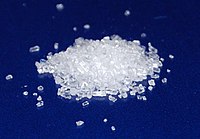
Photo from wikipedia
Cryptocaryon irritans is one of the most harmful marine parasites in mariculture. Copper sulphate is often used to kill parasites and the influence of copper sulphate on the tomont stage… Click to show full abstract
Cryptocaryon irritans is one of the most harmful marine parasites in mariculture. Copper sulphate is often used to kill parasites and the influence of copper sulphate on the tomont stage of C. irritans was explored in this study. The results showed that excystment rate was not significantly affected when tomonts were exposed to 5 mg/L (76.7%) and 10 mg/L (78.9%) of copper sulphate for 3 h. However, excystment rate was significantly inhibited when exposed to 15 mg/L (33.3%) for 3 h and 5 mg/L (28.9%), 10 mg/L (33.3%) and 15 mg/L (33.3%) for 6 h. After treatment with high concentrations of copper sulphate, the interior of the tomonts was fuzzy under the microscope, and the division process could not be observed. Metabolomic results combined with preliminary transcriptome analysis results showed that the tomonts were induced to produce linoleate, riboflavin, inositol and other substances under the stress of Cu2+ , which affected the antioxidant mechanism of the body. Using MDA content determination and antioxidant enzyme activity analysis, copper sulphate was found to cause oxidative damage to tomonts by affecting the generation of metabolites, leading to the death of tomonts.
Journal Title: Journal of fish diseases
Year Published: 2023
Link to full text (if available)
Share on Social Media: Sign Up to like & get
recommendations!